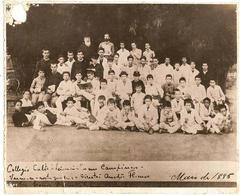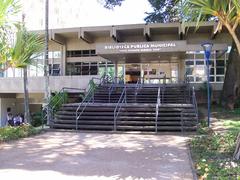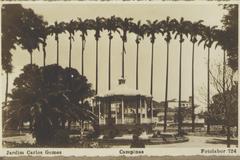Visiting Estação Anhumas: A Comprehensive Guide to History, Tickets, and Tips
Date: 18/07/2024
Why Visit Estação Anhumas?
Estação Anhumas, nestled in the vibrant city of Campinas, Brazil, stands as a historical testament to the region’s rich coffee heritage and architectural grandeur. Originally inaugurated on August 3, 1872, as part of the ambitious railway expansion by the Companhia Paulista de Estradas de Ferro (Paulista Railway Company), the station played a pivotal role in connecting the coffee-producing regions of São Paulo to the port of Santos. Designed by the esteemed French architect Victor Dubugras, the station’s neoclassical architecture, with its symmetrical facade and elegant arches, symbolizes Campinas’ prosperity during the coffee boom of the 19th century.
Over the years, Estação Anhumas has undergone several transformations, reflecting the evolving needs and growth of Campinas. Today, it houses the Museu do Café (Coffee Museum), offering visitors an immersive experience into the history of coffee production and its impact on the city’s development. The station, recognized as a heritage site by CONDEPHAAT in 1982, continues to be a vital hub for rail travel while preserving its historical and cultural significance. This guide aims to provide comprehensive visitor information, local insights, and essential tips to ensure a memorable and enriching experience at Estação Anhumas.
Explore Our Guide
- Introduction
- Historical Background and Significance
- The Rise of the Coffee Industry and the Birth of a Station
- Inauguration and Early Years
- Architectural Significance
- Transformation and Modernization
- A Legacy Preserved
- Estação Anhumas Today
- Visitor Information
- Tickets, Hours, and Accessibility
- Special Events and Guided Tours
- Photographic Spots
- Local Insights and Travel Tips
- Best Time to Visit
- Getting There
- Essential Tips for Visitors
- Conclusion
- FAQ
Visiting Estação Anhumas: A Historical Train Station in Campinas - Tickets, Hours, and More
Introduction
Estação Anhumas, a historical train station located in Campinas, Brazil, stands as a testament to the city’s rich past and its pivotal role in the coffee boom of the 19th century.
Historical Background and Significance
The Rise of the Coffee Industry and the Birth of a Station
The history of Estação Anhumas is intricately linked with the rise of the coffee industry in Brazil. In the 19th century, coffee cultivation spread across the fertile lands of São Paulo state, with Campinas emerging as a major production center. This economic boom fueled the need for efficient transportation to ship the coffee beans to ports for export.
Recognizing this need, the Companhia Paulista de Estradas de Ferro (Paulista Railway Company) was founded in 1868 with a vision to connect the coffee-producing regions of São Paulo’s interior to the port of Santos. This ambitious project led to the construction of a railway line that would forever change the landscape and fortunes of Campinas.
Inauguration and Early Years
Estação Anhumas, inaugurated on August 3, 1872, marked a significant milestone in this railway expansion. The station, originally named “Campinas,” served as a crucial junction connecting the city to Jundiaí and, subsequently, to the bustling port of Santos. This connection was instrumental in facilitating the flow of coffee from the plantations to the international market, solidifying Campinas’ position as a key player in the global coffee trade.
Architectural Significance
The station’s original structure, designed by the renowned French architect Victor Dubugras, is a testament to the architectural trends of its time. Dubugras, known for his significant contributions to Brazilian architecture, imbued the station with a distinct neoclassical style, characterized by its symmetrical facade, elegant arches, and intricate detailing. This architectural grandeur served as a symbol of Campinas’ prosperity and its connection to the wider world.
Transformation and Modernization
As the city of Campinas grew and evolved, so did its main railway station. In 1901, a new and larger station building, designed by Christiano Whitaker, was inaugurated adjacent to the original Dubugras structure. This expansion reflected the continued growth of the coffee industry and the increasing demand for rail travel.
The original Dubugras building, no longer serving as the main passenger terminal, was repurposed to house the offices of the Companhia Paulista de Estradas de Ferro. This change marked a shift in the station’s function, but it remained a vital hub for the railway company’s operations.
A Legacy Preserved
Despite the decline of the coffee industry in the early 20th century, Estação Anhumas continued to play a vital role in the life of Campinas. It remained a major transportation hub, connecting the city to other parts of Brazil.
Recognizing its historical and cultural significance, Estação Anhumas was listed as a heritage site by CONDEPHAAT (Council for the Defense of Heritage, Archaeology, Art, and Tourism) in 1982. This listing ensured the preservation of this architectural gem and its historical legacy for generations to come.
Estação Anhumas Today
Today, Estação Anhumas stands as a proud symbol of Campinas’ rich history. The original Dubugras building, carefully restored to its former glory, now houses the Museu do Café (Coffee Museum). This museum offers visitors a fascinating glimpse into the history of coffee production in Campinas and its impact on the city’s development.
The newer station building continues to serve as a functioning train station, a testament to the enduring importance of rail travel in the region. Estação Anhumas, with its blend of historical charm and modern functionality, serves as a vibrant reminder of Campinas’ journey from a bustling coffee center to a modern metropolis.
Visitor Information - Tickets, Hours, and Accessibility
When planning your visit to Estação Anhumas, it’s essential to know the practical details:
- Visiting Hours: The station and the Coffee Museum are open from 9 AM to 5 PM, Tuesday through Sunday.
- Tickets: Admission to the Coffee Museum is R$10 for adults and R$5 for children and seniors. Train rides vary in price depending on the journey length.
- Accessibility: The station is wheelchair accessible, with ramps and elevators available for visitors with mobility needs.
Travel Tips and Nearby Attractions
- Travel Tips: Arrive early to avoid crowds and ensure you have enough time to explore both the museum and the station. Wear comfortable shoes, as there’s plenty to see and walk around.
- Nearby Attractions: Don’t miss the opportunity to visit other historical sites in Campinas, such as the Jequitibás Forest and the Campinas Municipal Market. These sites offer a broader understanding of the city’s rich cultural heritage.
Special Events and Guided Tours
Estação Anhumas hosts various special events throughout the year, including historical reenactments, art exhibitions, and cultural festivals. Guided tours are available for groups, providing an in-depth look at the station’s history and architecture. To book a guided tour, contact the station’s visitor center in advance.
Photographic Spots
Photography enthusiasts will find numerous spots around Estação Anhumas for capturing stunning images. The neoclassical architecture of the Dubugras building, the vintage trains, and the picturesque surroundings make for perfect photo opportunities.
Conclusion
Estação Anhumas is more than just a train station; it’s a living museum that tells the story of Campinas’ past and its journey into the present. Whether you’re a history buff, an architecture enthusiast, or simply looking for a unique travel experience, a visit to this historical site is a must. Download our mobile app Audiala for more updates, explore other related posts, and follow us on social media to stay informed about the latest happenings.
FAQ
Q: What are the visiting hours for Estação Anhumas?
A: Estação Anhumas is open from 9 AM to 5 PM, Tuesday through Sunday.
Q: How much are the tickets for guided tours?
A: Adults - $10, Children (6-12) - $5, Seniors - $7.
Q: Is Estação Anhumas accessible for visitors with disabilities?
A: Yes, the station is wheelchair accessible and has facilities for visitors with disabilities.





